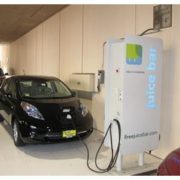After driving my all-electric Nissan Leaf four-door hatchback for two years, my final conclusion is that it is absolutely the perfect second car for most American families. Some 90% of all US driving is less than 40 miles a day, and this car is targeted at that market.
If a spouse has a reliable daily round trip commute of less than the car?s 80-mile range, this is your car. The ideal combination is to own a Leaf and a hybrid SUV for those long distance ski weekends, visits to out-of-state relatives, and road trips in general.
The real revelation comes when you realize that this is a car that creates its own fuel. When I depart the Berkeley Hills and reach the entrance to the Oakland Bay Bridge ten miles away, I have more power than when I started. That?s because the trip is entirely downhill. Wow!
There are other benefits beyond flipping your local Exxon station the bird when you cruise by. I often find handwritten notes stuck under my windshield wipers from young women asking for rides. When you are 61, such offers come increasingly few and far between. That alone is worth the cost of purchase. Now, I only use gas station for their toilets and air pumps, which somehow seems appropriate.
You can get all of this for $38,000, of which $7,500 can be applied as a federal tax credit. Or you can go to your local Nissan dealer, where you can pick up a used model in new condition with 16,000 miles on the clock for $20,000. Given that you are no longer spending $4,000 a year on gas and tune ups, you easily amortize the entire cost of a new car in in ten years. Expect to get a lot of thumbs up from bystanders as you silently drive by.
This is not a souped up golf cart by any means. After comfortably sliding my 6?4? frame behind the wheel, I asked the salesman to pack the car with beefcake so I could give it a real test. Three farm boys from Tennessee, real heifers, dutifully piled in. It made no difference; the car took off like a Porsche.
When I first got the car, I tore off down the freeway at 90 mph, gleefully weaving in and out of the lumbering, gas guzzling GM Suburban?s, Cadillac Escalades, and Ford Excursions that inhabit California state highway 24. Eventually I throttled off, lest I get California?s first zero emissions speeding ticket.
The Leaf can be recharged from dead flat at home on a 240-volt plug in eight hours, or at your friend?s house in 16 hours at 110 volts. A GPS mapping system constantly displays your remaining range, as well as the locations of the nearest charging stations. If you run out of juice on the freeway, Nissan offers free roadside service with an immediate recharge. With a 600-pound lithium ion battery lining the bottom of the chassis, it has tremendous stability, and corners like it is on rails. The battery comes with an eight-year warranty and a ten-year life.
One problem is that the car is utterly soundless. That is an issue driving in shopping mall parking lots, when clueless kids, especially those wearing ear buds, walk directly in front of a moving car. It is just a matter of time before the state mandates required cartones for electric cars in motion.
When I took delivery of one of the first American Leaf?s, I was a pioneer. The entire San Francisco Bay area had only 25 public charging stations. More than a few times I ducked into sushi shops with a 100-foot extension cord in search of enough juice to get home. Once, I convinced the bemused parking attendants at the San Francisco Opera House to unplug their coffee machine to recharge my car. Even then, I coasted into my garage on my last couple of electrons, the car shouting warnings at me all the way. The pathfinder days are now long gone. Today, there are over 500 charging stations in this part of California.
I have to say that it helped being a pilot and a scientist. Calculation of range and fuel consumed to destination come as second nature to me. If I didn?t, I would have found my place at the bottom of the Atlantic, the Pacific, or the Persian Gulf, ages ago. So I would think twice about buying one of these for a right-brained high school English teacher with no technical aptitude whatsoever.
Figuring out the car?s actual performance was a mutual learning experience for both Nissan and me. There were quite a few calls to their engineers to discuss glitches and workarounds in the early days. Finally, Nissan sent a product development guy from Japan to discuss design of the second generation Leaf. By the way, their stock has been on fire for the past three months, up some 25%, as the weakening yen boosts their global competitiveness.
My local utility has been cheering from the sidelines. PG&E is offering a special Plug-in-Vehicle rate of only 4.6 cent per kilowatt hour from 12:00 am to 7:00 am, compared to the standard top tier rate of 40 cents per hour, an 89% discount. That means the Leaf?s 80-mile trip cost me 92 cents. This is the same as buying all the gasoline I want at 23 cents per gallon! In other words, the fuel is basically free.
When I asked the chief engineer about maintenance costs, I got a blank stare. Then he answered in a deadpan fashion, ?there is no maintenance?. During the first 100,000 miles, the only expenses will be for brake pads and tires, as the 107 horsepower electric induction engine only has five moving parts operating at room temperature. Even the brake pads last forever, since the regenerative braking system does most of the stopping to generate more electric power. Instead of tune-ups, you get software upgrades. Only the tires need to be rotated every 8,000 miles.
Alas, it is time for me to move on from my beloved Leaf. As with a first high school love, the excitement of the unfamiliar eventually wears off, and you start looking to trade up. I also could use more performance. In the electric, zero emissions car world, that means buying a brand Tesla S-1 performance model (TSLA), which I will pick up at the Fremont, California factory as soon as I finish writing this letter. I?ll let you know how she works out, once I have broken her in.





